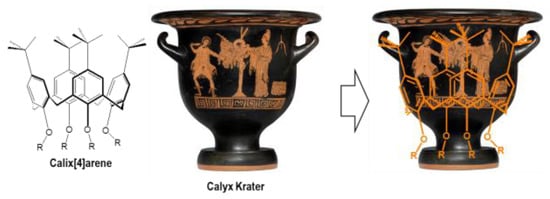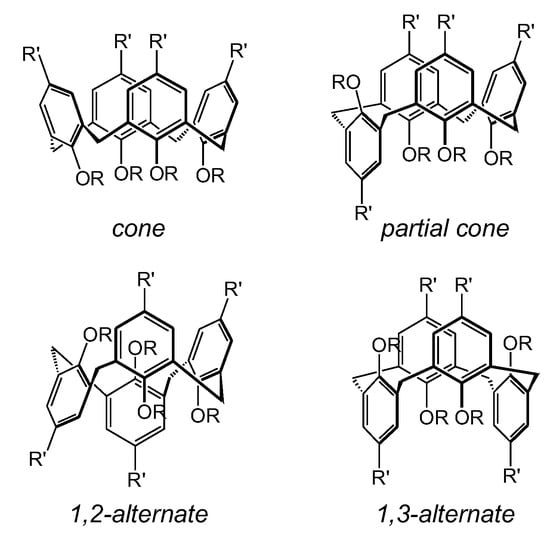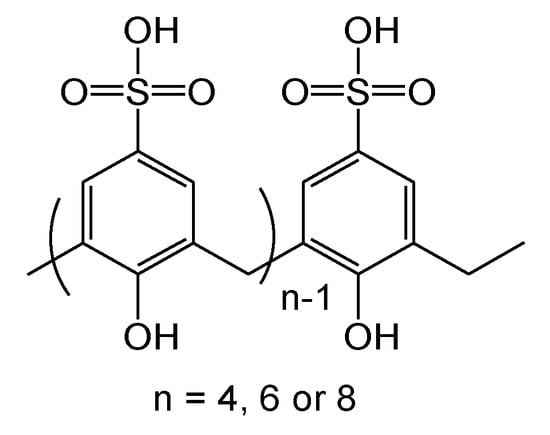Since the discovery of polyphenolic resins 150 years ago, the study of polymeric compounds named calix[n]arene has continued to progress, and those skilled in the art perfectly know now how to modulate this phenolic ring. Consequently, calix[n]arenes are now used in a large range of applications and notably in therapeutic fields. In particular, the calix[4]arene exhibits multiple possibilities for regioselective polyfunctionalization on both of its rims and offers researchers the possibility of precisely tuning the geometry of their structures. Thus, in the crucial research of new antibacterial active ingredients, the design of calixarenes finds its place perfectly. Out of all the work of the community, there are some excellent activities emerging that could potentially place these original structures in a very good position for the development of new active ingredients.
- calixarenes
- antibacterial drugs
- bacterial infections
1. The Structure of Calixarenes


2. The Functionalization of Calix[4]arene
The different nature of the two rims available on the calixarene skeleton allows for selective functionalization on the upper rim (functionalization of the para carbon of the aromatic nucleus) or on the lower rim (functionalization of the phenolic hydroxyl) (Figure 2). Concerning the upper rim, it can be modified by aromatic nucleophilic substitution, via halogenation [19][20][73,74], nitration [21][22][75,76], sulfonation [23][24][25][59,61,77], acylation [26][27][78,79], or other means. In addition, on the native, para-tert-butylated calixarene, it is possible to completely or selectively detertiobutylate by first passing through the protection of the OH of the phenolic rings on which it is desired to retain a para-substitution [28][80]. On the other hand, the lower rim allows, via the reactive hydroxyl groups, the introduction of various arms by formation of ether or ester bonds [29][81]. In the case of calix[4]arene, the lower rim has four hydroxyl groups engaged in a network of intramolecular hydrogen bonds favoring the conical conformation (Figure 2). These strong hydrogen bonds lead to different pKa values for the hydroxyl groups involved in this ring [30][82]. This allows the establishment of various regio- and stereo-selective functionalization procedures on the lower crown. It has been shown that by implementing a carrier ion effect (“template effect”) relating to the nature and strength of the base used, it is possible to stereospecifically incorporate different substituents on the lower part of the calixarene. It is thus possible to substitute in the lower rim a calix[4]arene with 1 to 4 groups and, moreover, for bis-functionalization, a possibility of regioselectivity in the 1,2-adjacent or 1,3-alternated position [31][32][33][34][35][36][37][38][39][40][83,84,85,86,87,88,89,90,91,92].3. Cytotoxicity of Calix[n]arenes
To develop biomedical applications, research into strong, possibly deleterious, interactions between the design molecular object and the biological target (cell, protein…) must examine the toxicity of various biological entities that these objects could potentially encounter before reaching their target. This is the case for the calixarene derivatives, more particularly the water-soluble ones, with the increase in interest which devoted to them for various biological applications and potential clinical studies. Relatively rare some twenty years ago, these studies are beginning to appear, and almost all converge towards the fact that this structure seems to have no toxicity or immunogenicity [41][42][93,94]. For example, the para-sulfonatocalix[n]arenes (Figure 3), widely used for numerous biomedical applications (anti-viral, anti-thrombotic, protein complexation, anti-coagulant…) exhibit an innocuous character with regard to studies conducted until this date [43][35]. It thus has very low toxicity on red blood cells [44][95], no toxicity against neutrophils involved in immune response [45][97], against the human ovarian carcinoma cell line A2780 and its equivalent cisplatin-resistant cell line A2780cis [46][99], as well as against L-132 epithelial cell line [47][100] or HL50 cells (i.e., human leukemia cells) [48].[101]
4. Antibacterial Activities of Calix[n]arenes
4.1. Intrinsically Active Calixarenes
 Figure 4. Examples of intrinsically active calixarenes: macrocyclon, peptidocalix[4]arenes, guanidinium and ammonium calix[4]arene respectively from left to right
Figure 4. Examples of intrinsically active calixarenes: macrocyclon, peptidocalix[4]arenes, guanidinium and ammonium calix[4]arene respectively from left to right
Subsequently, very good results appeared, for example, for peptidocalix[4]arenes (Figure 4) with good activity against MRSA (methicillin-resistant S. aureus) (4 to 8 µg/mL) [57][58][59][115, 116 ,117]. From 2006, calix[4]arene positively charged by the introduction of guanidinium functions showed excellent activities on reference bacterial strains (Figure 4). These last introduced on the upper rim displays a significant antibacterial activity (MIC <8 µg/mL) against the bacterial reference strains E. coli, S. aureus, E. faecalis and P. aeruginosa [18][60][72,103], but also on the clinical isolates penicillinase producing E. coli, methicillin-resistant S. aureus, vancomycin-resistant E. faecium, vancomycin- and teicoplanin-resistant E. faecalis, and P. aeruginosa overexpressing efflux pumps [61][120]. This guanidinium calixarene and its derivatives also have very good activity against a particular strain: Mycobacterium tuberculosis [60][62][103,132].
Another examples concern a water-soluble macromolecule based on calix[4]arene and morpholine units [63][133], appears to have an excellent activity profile with the inhibitions of growth were measured at 4 µg/mL against gram-positive and gram-negative species, but also a serie of azo compounds [64][141] showing very good activities through CMI measurements on five Gram-positive bacterial strains (B. subtilis, S. aureus, methicillin-resistant S. aureus (MRSA), S. epidermidis, and E. faecalis) (<10 µg/mL).
Finally, a recent study confirms the interest of calixarenes carrying cationic functions but also of the impact of conformation [65][147] (Figure 4) as described in a previous study [60][103]. Indeed, the ammonium derivatives concerned exhibit activities close to 1 µg/ml against Gram-positive and Gram-negative strains.
4.2. Molecular Carrier/Drug Delivery
These studies propose, for example, the introduction of penicillin via amide or ester functions, which should release the biologically active free acid and amine after hydrolysis by esterases [66][67][149,150] (Figure 5). The same strategy allows the synthesis of bis-quinolone derivatives [68][69][151,152] and a study of the anti-bacterial activity against Gram-positive reference ATCC strains, S. aureus and E. faecalis, as well as against two Gram-negative reference strains E. coli and P. aeruginosa. Designed as hydrophobic compounds, these structures are not really easy for in vitro standard evaluation as antimicrobial agents. Thus, an additional study proposes the development of water-soluble compounds via the introduction of ammonium functions [70][156]. Other researchers have also obtained promising results through the synthesis and biological evaluation of penicillins V and X clustered by a calixarene scaffold [71][157] and the corresponding cephalosporine derivatives [72][158] (Figure 5). The impact of cyclotetramerization was demonstrated by a notable increase in activity on all penicillin cyclotetramer strains versus monomers.

Figure 5.
Examples of molecular carriers/drug delivery: penicillin (left) or cephalosporine (right)
4.3. Complexes
In this sense, researchers have developed complex structures of mononuclear copper [73][74][163,164] (Figure 6) for their antibacterial activities against Gram-positive (B. subtilis, B. cereus, E. faecalis (clinic sample), S. aureus) and Gram-negative bacteria (E. coli, E. coli, P. aeruginosa, Proteus vulgaris) or binuclear [75][166] (Figure 6) active against Gram-positive S. albus and Gram-negative E. coli. On the other hand, the thiosemicarbazide moieties and their thiosemicarbazone derivatives known for their ability to coordinate with transition metals by bonding with sulfur and nitrogen atoms [167,168] allowed the development of cobalt (II), nickel (II), copper (II), or zinc (II) complexes.

Figure 6. Examples of mononuclear copper (left) and binuclear copper (right) complexes
Examples of mononuclear copper (left) and binuclear copper (right) complexes
